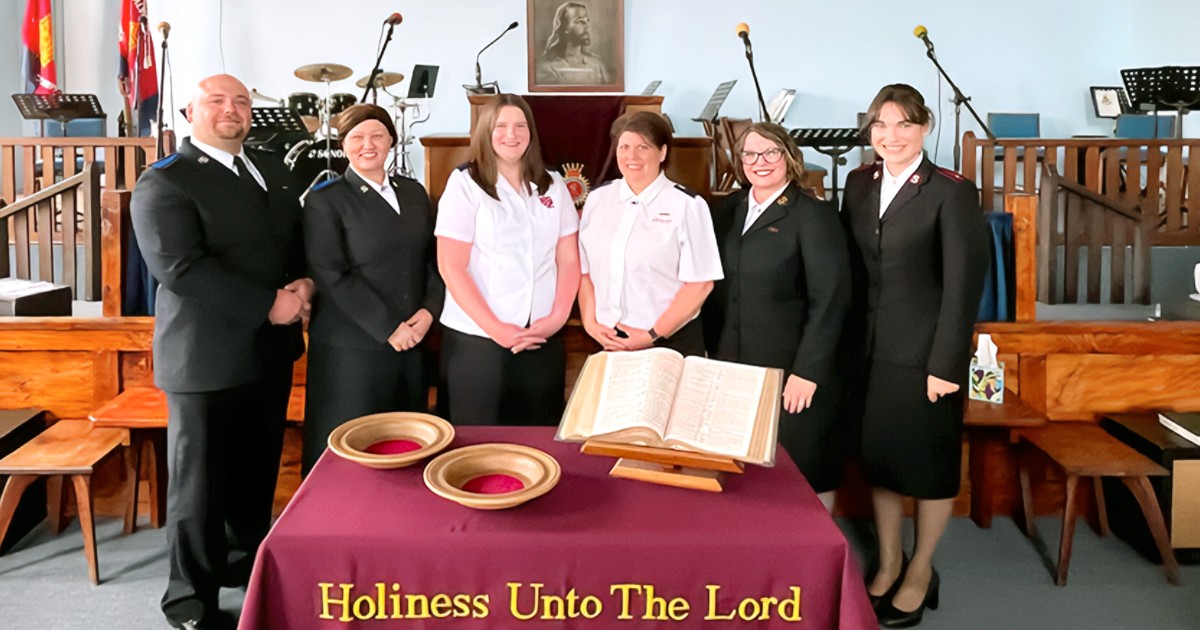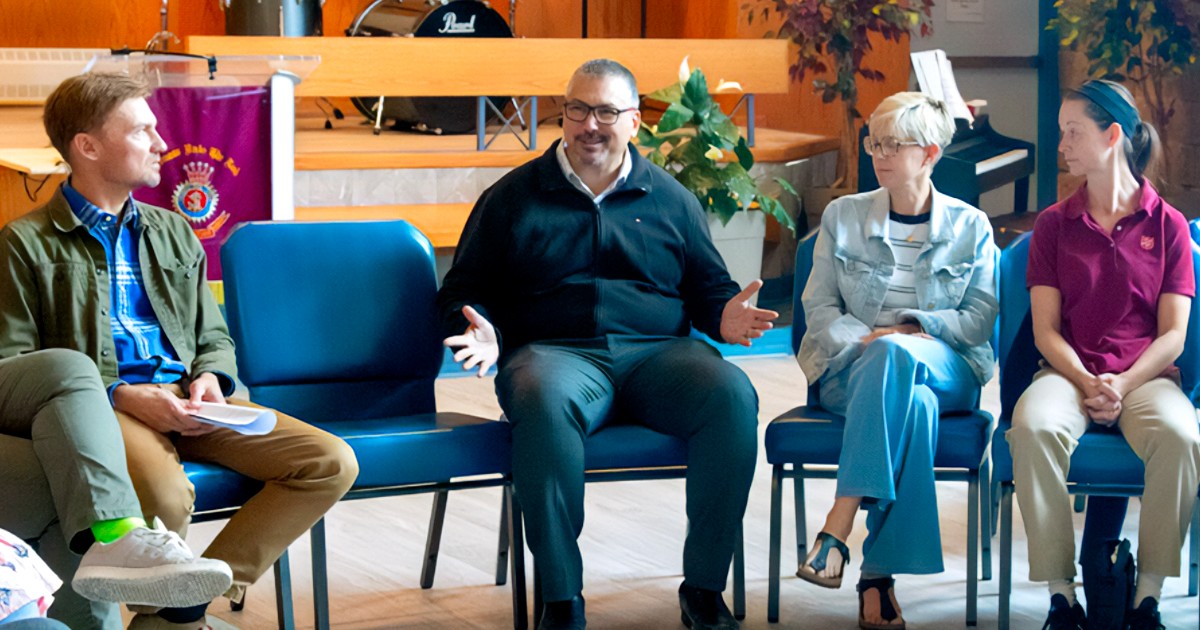On Good Friday, a procession of churchgoers, tourists and actors weaves through the scenic town of St. George’s, Bermuda, led by a Salvation Army band. Some are dressed in costume as Pharisees and disciples, and among them, a determined Jesus carries a cross on his back. This annual re-enactment, called the Walk to Calvary, draws hundreds to St. George’s and brings Christ’s Crucifixion story to new audiences each year.
“The Walk to Calvary is nothing short of spectacular. It has become one of the most significant events on the St. George’s calendar,” says Major Wayne Knight, a native Bermudian and former corps officer at St. George’s Corps, where he and his wife, Captain Elizabeth Knight, served for seven years. “Many people, especially those who may not have a Christian background, don’t know what Good Friday is about. So, this re-enactment is an amazing way to share that story.”
The St. George’s Corps and North Street Citadel bands accompany the procession, playing music and Easter hymns from the Salvation Army tune book. “I see the Walk to Calvary as a way that God uses us,” says Jamel Bean, bandmaster at North Street Citadel. “It’s another way that we can serve, draw and encourage others to come to have a relationship with him.”
The Sacred Journey
Bermuda’s unique architecture sets the stage for the re-enactment, with old churches and palm trees reminiscent of the Holy Land. At six different locations, the actors stop to deliver lines from Scripture—a different translation is chosen each year—and the narrative comes to life.
“It feels very historical, almost like you’re there in the biblical days,” explains Lieutenant Almeta Ward, corps officer at St. George’s Corps, who plays a defender of the faith in this year’s event. “We go to a garden for the scene where Peter denies Jesus, and as you look at the garden and palm trees, you feel as if you are in the scene with them. It is very powerful.

St. George’s Corps, one of the stops on the Walk to Calvary’s route, is where a worried conversation between the disciples takes place. “Up to this point, the disciples have been hiding because they are afraid,” explains Lieutenant Ward. “Now they gather to ask, ‘What have we done?’ ‘How can we find Jesus?’ And so, as people cross the alley on their way to the next scene, they overhear this conversation as if they are passersby.”
The Walk to Calvary ends when the procession crosses a bridge from King’s Square to Ordnance Island, a small but historic island in St. George’s Harbour. Here, the dramatic re-enactment of Christ’s Crucifixion takes place, with Jesus on the cross flanked by two criminals, one hurling slurs and the other asking for mercy. And then, like the repentant thief, the crowd of spectators is invited to accept Christ into their lives.
In closing, those in attendance are encouraged to attend a united sunrise service on Ordnance Island to celebrate the Resurrection on Easter Sunday.
A Part to Play
While the Walk to Calvary has been an annual event for more than 40 years, this year is the first for Lieutenants Almeta and Lester Ward, who were appointed as corps officer at St. George’s Corps and executive director, Bermuda Community Services, respectively, last summer. Though they’re new, Lieutenants Ward decided they wanted to experience the Walk to Calvary for the first time as acting participants. But after their first week of rehearsals, they knew it was going to be challenging.

“After every rehearsal, we come away thinking, This is so powerful, but so difficult,” says Lieutenant Almeta Ward, whose role requires her to be vocal and energetic, and to act out painful scenes from the Bible. “It’s not a joyous role—Jesus’ Passion is not joyous until Easter Sunday—and I’m one of the characters who goes up to Jesus after he’s been hit, laughing and mocking him.”
In conversation with Reverend Cyril Simmons of Ebenezer Methodist Church in St. George’s, the actor who has played Jesus in the Walk to Calvary for many years, Lieutenant Ward learned that prayer is vital to her role. “He told me that it can be exhausting, and that we’ll need to pray about it,” she says. “We want to put everything into the performance so that we can give the real effect, but as Christians, it is hard to do and say these things. There is a lot of prayer surrounding this event.”
Together at the Cross
Putting on an event of this scale is a significant undertaking—one that’s made possible by the enthusiastic co-operation of the local churches. According to Major Knight, there is a strong relationship between the various churches in St. George’s who often participate in united services at Christmas and Easter. The Walk to Calvary is a joint effort between the diverse denominations that come together as part of the East End Ministerial Alliance to plan, produce and host the event each year.
Despite its small size, Bermuda has a significant number of churches—110 in total, with one church per square mile. “You turn your head, and you’re going to see some churches. There’s just that many on the island,” says Bean, who has participated in the Walk to Calvary for more than a decade.
“It makes me proud that The Salvation Army can be a part of the Walk to Calvary, and I feel blessed that they’re going to stop in front of our church for a scene,” says Lieutenant Ward. As the corps officer, she believes the event strengthens both the church and the Army’s ties to the community.
For the church, it reminds the congregation that they are part of something greater—collective kingdom work in partnership with other churches. “It encourages them and reminds them that, although we are different denominations, we are all part of one body,” says Lieutenant Ward. “We have the same goal. We worship the same God.”
And in terms of the community, it deepens The Salvation Army’s involvement and presence in St. George’s, and spreads awareness about the work it does. “We have met so many people that we didn’t know before. They might know us as the corps officers at The Salvation Army, but it’s nice to introduce myself to them and to tell them that if there’s anything that the Army can do for someone in their congregation, in terms of social services, we are here.”
All Walks of Life
“One thing I appreciate about the Army’s history in Bermuda is that many people, whether they go to another church or, in some cases, may not go to church at all, will say they have a connection to the Army,” says Bean. “So, for some of them, that is one reason why they come out for the Good Friday re-enactment.”

For others, the Walk to Calvary may be their first time learning the story of Christ’s Crucifixion. Some are tourists, drawn by Bermuda Tourism, which offers packages at a nearby resort for the Walk to Calvary experience, accommodations and other Easter weekend activities. To see the vivid, emotional and even graphic scenes play out in front of them offers an immersive first impression for those who haven’t read the Bible, attended church or Sunday school, or watched popular Easter films such as The Passion of the Christ.
“People from all walks of life come out to this event. It’s not just the believer who is coming,” says Bean, who sees it as an avenue for spreading the gospel. “On Good Friday, we know we are playing music for God’s glory and planting seeds in the lives of those who are there. Whether it comes by way of seeing Jesus on the cross, or by hearing the band play songs from the tune book and thinking, I wonder how I could be part of that? someone might come to have a relationship with God.”
According to Bean, the most rewarding aspect of participating in the Walk to Calvary year after year is seeing the impact that it has on those who watch. It is an opportunity to both challenge and encourage spectators to come to know Christ, or to strengthen or renew their relationship with him.
“We may not know right away how our actions have impacted somebody. We may not know until we see them face to face in heaven,” says Bean. “It’s about allowing ourselves to be used by God in whatever opportunity we are given.”
Photos: Walk to Calvary Bermuda










Leave a Comment